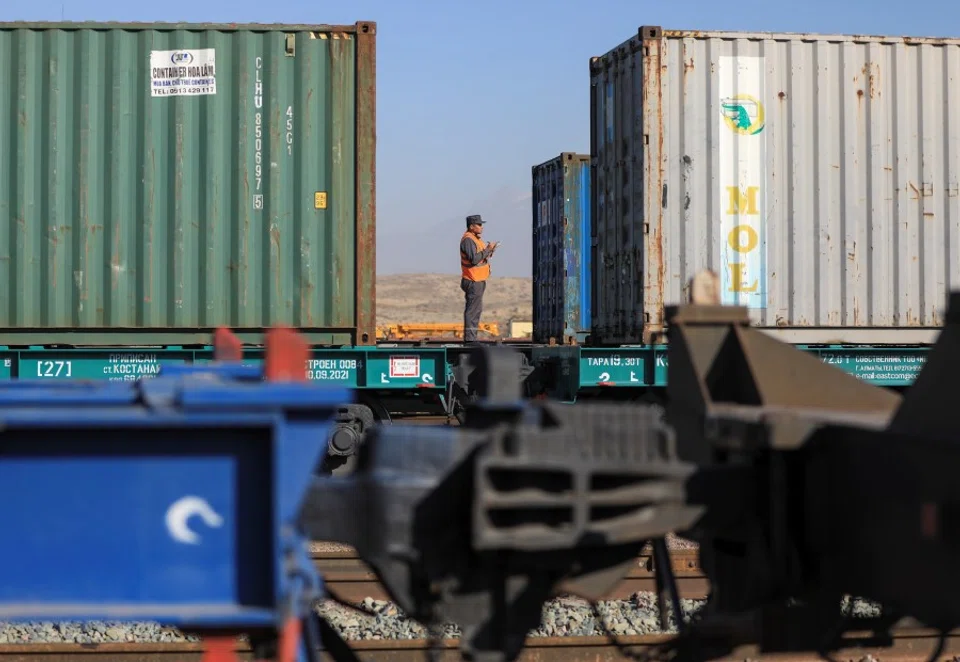China's BRI carrots for Central Asia come with potential pitfalls
China-Central Asia relations have been growing for mutually beneficial reasons, and the Belt and Road Initiative (BRI) has been a chief conduit of that. Projects have gone beyond just infrastructure to other areas such as health and digital development. But the Central Asian countries will have to navigate possible pitfalls in order to reap the benefits while minimising the threats to national sovereignty and risk of social backlash.

Central Asia is recognised as a geographical region that comprises five countries, namely Kazakhstan, Uzbekistan, Tajikistan, Kyrgyzstan and Turkmenistan. These countries declared independence from the Soviet Union in December 1991.
Central Asia is also one of the key regions for China's foreign policy under the Belt and Road Initiative (BRI). The Silk Road Economic Belt, which forms the continental component of the BRI, was launched by Xi Jinping, China's president, during a speech at Nazarbayev University in the Kazakh capital in September 2013.
Historically, Central Asia was a key participant in the ancient Silk Road trade until its decline by the mid-15th century. Uzbekistan's Samarkand is an ancient Silk Road city.
China's relations with Central Asian countries have been visibly picking up pace in recent years. The implementation of the BRI has helped to expand China's economic influence in Central Asia. In contrast, the US is unable to challenge China's clout in the region in terms of economic and trade cooperation, or infrastructure development.
... China also views Central Asia as crucial for safeguarding its national security in its western region in general and Xinjiang in particular.
From a geographical perspective, Central Asia is situated in a prime location in relation to overland trade routes linking East Asia with Europe. Access to this region is thus vital to guaranteeing open passage for the Silk Road trade routes.
From an economic perspective, Central Asia is rich in oil, natural gas and mineral resources. China needs energy and other mineral resources from this region to power economic growth at home.
Moreover, China also views Central Asia as crucial for safeguarding its national security in its western region in general and Xinjiang in particular. Kazakhstan, Tajikistan and Kyrgyzstan share a 3,300-kilometre border with Xinjiang, the most troubled region in China in terms of maintaining stability.
Central Asian countries are keen to participate in the BRI as it offers an alternative to the conventional Russian domination of the region's political, economic and strategic spheres.

Central Asian countries are keen to participate in the BRI as it offers an alternative to the conventional Russian domination of the region's political, economic and strategic spheres. The BRI could be instrumental in facilitating cross-border trade and investment across the regional countries through its focus on infrastructure connectivity improvement.
Central Asian nations aim to improve their transportation and other infrastructure to overcome their landlocked geographical disadvantage, boost local economic growth and better participate in global trade networks. Central Asia hence views China as a much-needed source of foreign investment for improving the region's infrastructure connectivity.
Central Asia's economies are overly dependent on the energy and mineral extraction sectors. The economic diversification strategy long pursued by the respective governments in Central Asian countries has so far achieved little progress.
The five Central Asian states have large agricultural sectors and weak manufacturing industries, in addition to outdated infrastructure facilities and limited exposure to global value chains. Moreover, Central Asian states have long been afflicted by rampant corruption, high unemployment, and widening wealth inequality between the small politically connected elites and the ordinary mass.
The unprecedented turmoil in Kazakhstan at the beginning of 2022 is a vivid example of the vulnerable and volatile political and social situation in Central Asia. In Almaty, the epicentre of Kazakhstan's unrest, gunfire echoed through government buildings and streets.
The unrest has now been brought under control, at least temporarily. However, the bloodshed resulted in hundreds of casualties and thousands of arrests of people. Factors contributing to the unrest in Kazakhstan go deeper than the petrol price hike, and include the accumulation of political, social and economic factors which have been left unresolved by the government.
In 2019, 22% of Central Asian countries' exports went to China, whilst 37% of their imports were from China...

BRI in Central Asia
The trade routes under the BRI umbrella are helping to further boost bilateral trade in goods between China and Central Asia. In 2019, China's total trade volume with the five Central Asian countries was worth US$46.77 billion, with China enjoying a trade surplus of US$5.55 billion.
China's trade with Central Asia accounts for a small fraction of the former's total foreign trade. While China's trade dependence on Central Asia is extremely low (Central Asia accounted for merely 1% of China's total volume of trade in goods in 2019), China is among Central Asia's most important trading partners. In 2019, 22% of Central Asian countries' exports went to China, whilst 37% of their imports were from China, says a Carnegie Moscow Center report.
... the influx of Chinese workers to Central Asia as a result of Chinese investment has generated negative perceptions and anti-Chinese resentment in society.
China enjoys a huge trade surplus with countries in Central Asia, but the trade deficit has also been widening over the years. Energy and mineral resources, and agricultural raw materials still dominate Central Asian countries' exports to China, whilst their imports from China mainly include China-made machinery, electronics and equipment. This asymmetrical trade relationship is detrimental to Central Asia's pursuit of industrialisation and is not sustainable.
In addition, the inflow of Chinese direct investment to Central Asia has increased dramatically in recent years. Most of these Chinese investments in Central Asia were directed to joint ventures in the industrial sectors of oil, natural gas, mining and infrastructure construction.
Nevertheless, the influx of Chinese workers to Central Asia as a result of Chinese investment has generated negative perceptions and anti-Chinese resentment in society. The locals' concern about the disproportionate use of Chinese migrant workers in the China-funded projects and Chinese companies provoked anti-China protests of various scales in Kazakhstan and Kyrgyzstan in 2018 and 2019 respectively.
Readjustment to the BRI implementation
In the face of pressure from the authorities and people of the Central Asian countries to look into the needs of the local manufacturing industries, local job market and tax revenue, China has made several major readjustments to the BRI and its related project implementation in the region since 2019.
First, there has been a gradual shift of Chinese investment in the region from the energy and mining sectors to agriculture and industries. China has started to help regional countries to industrialise by setting up manufacturing and processing plants for raw materials. Chinese firms are also helping to modernise textiles, cement, steel and glass factories in Tajikistan, Kyrgyzstan and Uzbekistan.

Second, besides building local industrial capacity and localising the workforce, Chinese firms are helping to upgrade local workers' skills through training. In Tajikistan, some Chinese companies, for example, the China National Petroleum Corporation (CNPC) and Huawei, have steadily increased their local hires and provided skills training for local workers both onsite and in China.
In May 2021, during a meeting with the foreign ministers of five Central Asian countries in China's Xi'an, China's State Councilor and Foreign Minister Wang Yi announced that China would further support upskilling of the local workforce by setting up a vocational training centre called the "Luban Workshop" (named after a legendary Chinese craftsman) in each of the five Central Asian countries over the next three years.
Third, the BRI was centred on large-scale infrastructure financing and construction in the earlier phase, but its scope has now expanded to include domains such as digitalisation and health. Leveraging China's digital technology advancement and its leading tech firms, the Digital Silk Road (DSR) is intended to cement China as a leading international technological power.
Although the Chinese government has not clarified what exactly constitutes the DSR, Chinese tech firms such as Huawei and ZTE are investing in digital infrastructure and related industries across the globe, including 5G cellular network, fibre optic cables, big data, cloud computing, artificial intelligence and satellite navigation systems (its own BeiDou system).
Fourth, China is actively promoting the Health Silk Road, through what is commonly known as China's vaccine diplomacy. China has already delivered over 37 million doses of Chinese-made vaccines to the Central Asian countries, the majority of which were delivered under sales agreements with the respective countries. Uzbekistan is the largest recipient country of Chinese vaccines in Central Asia. At a virtual summit with the five Central Asian countries in January, Xi pledged to donate an additional 50 million doses of Covid-19 vaccines to Central Asia this year.
As shown in Central Asia, the smaller the country and the closer to China geographically, the more it will be indebted to China.

While China has made some major readjustments to the BRI and its project implementation in Central Asia since 2019, the BRI in Central Asia has yet to become a global initiative based on high standards of transparency, sustainability and shared development that was promised by China. BRI-linked projects are largely lacking in transparency. Key financial details of many BRI-linked infrastructure projects have been kept away from public oversight, including the terms of their loan structure and the length of the lease.
Furthermore, the Central Asian countries are vulnerable to debt distress related to the BRI projects. As shown in Central Asia, the smaller the country and the closer to China geographically, the more it will be indebted to China.
In light of China's asymmetrical economic relations with the various Central Asian countries, these countries will need to act smartly in order to maximise the economic and infrastructure development benefits of the BRI while minimising the threats to national sovereignty and risk of social backlash. Central Asia's strategic location at the crossroads of Europe and Asia means it is one of the focal points in the contest for regional influence among the great powers. Central Asian states would thus need to balance and hedge in the face of these great powers. An initial version of this article was first published as an East Asian Institute Background Brief.



![[Photos] Fact versus fiction: The portrayal of WWII anti-Japanese martyrs in Taiwan](https://cassette.sphdigital.com.sg/image/thinkchina/3494f8bd481870f7c65b881fd21a3fd733f573f23232376e39c532a2c7593cbc)

